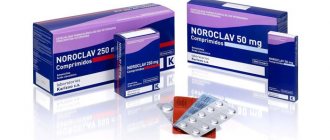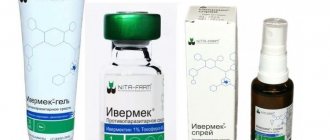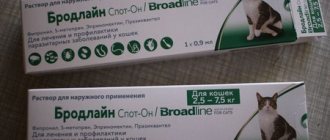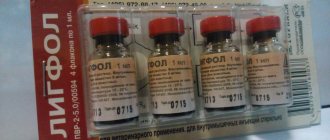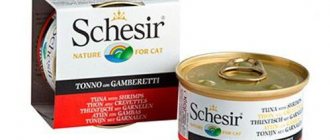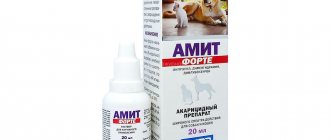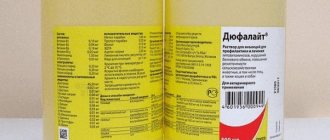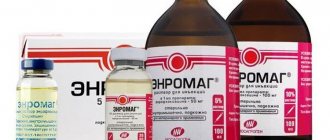Composition and action
The basis of the drug is ketoprofen, a propionic acid derivative that has antipyretic, analgesic and anti-inflammatory effects. Once in the body, after 30-40 minutes the active substance reaches its maximum concentration in the blood plasma, quickly penetrates through the bloodstream into all organs and tissues, acting on the source of pain and inflammation.
The manufacturer offers three types of tablets, differing in the content of ketoprofen: 5, 10, 20 mg. For cats, it is more convenient to use a drug with a minimum concentration: to avoid exceeding the therapeutic dose.
Ketoprofen inhibits destructive processes in joints and soft tissues during chronic inflammation, and during acute inflammation it quickly relieves pain, therefore Ketofen is actively used for injuries, acute inflammatory processes in joints, and musculoskeletal organs. In case of articular syndrome, it relieves pain during movement and rest, reduces morning stiffness, swelling of the joints, and increases the motor activity of the sick animal. A noticeable effect appears after a week of taking the drug.
Contraindications
Like any anti-inflammatory non-steroidal drug, ketoprofen is not recommended for stomach diseases: any acid negatively affects the gastric mucosa and can provoke acute gastritis or peptic ulcer.
Ketofen for cats is contraindicated in cases of renal failure and kidney disease, as well as in any diseases accompanied by liver and kidney dysfunction. This contraindication is due to the high toxic load on these organs when the active substance is excreted from the body.
In addition, ketoprofen affects blood clotting rates, so its use is not recommended for hemorrhagic pathologies and if there is a risk of bleeding in the case of surgical interventions or open injuries.
There is also a specific reaction - ketoprofen allergy, in which treatment with this drug is strictly contraindicated.
Ketofen for cats is available in two forms:
- tablets 5, 10 and 20 mg;
- solution for injection 1%
The dosage, dosage schedule and form of the drug must be prescribed by a doctor. Particular attention is paid to the dosage, which is calculated taking into account the weight of the animal: per kilogram no more than two milligrams of the active substance.
For acute pain, treatment usually begins with injections: for cats they are given only subcutaneously. The course of injections has strict restrictions: no more than one injection per day and no longer than three days.
For chronic pain, it is advisable to prescribe ketofen for cats in tablets. In this case, the duration of the course may be longer - up to 4-5 days.
Sometimes the doctor may prescribe a longer course of treatment, while reducing the dosage.
Step-by-step therapy with ketoprofen is considered the most effective: treatment begins with one injection, and the next day the sick animal is prescribed oral administration of the drug.
Instructions for use of the drug Ketofen for cats
Cats are very active and curious animals. Young cats try to explore everything, so they climb tall trees, cabinets and curtains. Experienced cats try to catch a bird or fly, putting themselves in danger. Such situations often lead to various types of injuries. And sometimes diseases (for example, joints) arise due to old age. One of the most popular drugs for the treatment of diseases of the musculoskeletal system is Ketofen.
Indications for use
The drug has the following effects:
- relieves inflammation;
- relieves swelling;
- eliminates body hyperthermia;
- relieves pain.
The effect is achieved due to the fact that ketoprofen blocks the production of substances involved in inflammatory processes. Therefore, the drug is recommended for use in the following cases:
- for arthrosis and arthritis;
- with dislocations;
- for herniated discs and other diseases of the spine;
- for fractures, bruises and other injuries;
- with edema of various etiologies.
Purpose
The drug exhibits the maximum therapeutic effect in relation to acute and chronic diseases of the locomotor system, due to which Ketofen is used in the treatment of:
- arthritis;
- arthrosis;
- injuries - fractures, bruises, dislocations, ruptures and sprains;
- herniated discs, etc.
Due to its pronounced analgesic effect, the drug can be used to relieve pain and inflammatory reactions after surgical interventions.
Important!
Ketofen has contraindications for use, so it cannot be used for self-medication.
In addition, the drug can be prescribed to relieve pain of various types, including:
- to relieve post-traumatic pain;
- with myalgia - muscle pain;
- for renal colic;
- in gynecological, oncological, neurological veterinary practice.
Arthritis is a group of joint inflammations often diagnosed in cats. This is a disease that most often affects middle-aged and elderly animals, but young pets are no exception. Pathology can be caused by various reasons:
- injuries;
- genetic predisposition (the risk group includes Maine Coons, Scottish Folds and exotics);
Joint damage can be inflammatory or degenerative in nature. In the first case, the pathological process develops in the synovium. The following types of inflammatory arthritis are distinguished:
- rheumatoid, caused by herpes viruses, retroviruses, mycoplasmas;
- infectious – develops when pathogenic bacterial microflora penetrates the joint. The cause may also be viruses and helminthic infestations;
- reactive – secondary damage to the joint, developing against the background of general intoxication of the body, accompanies infections of the gastrointestinal tract and genitourinary system;
- metabolic – develops when metabolic processes in the animal’s body are disrupted; the cause may be a lack of calcium and phosphorus obtained from food, heterochromatosis, etc.
When the superficial part of the joint is damaged, degenerative arthritis can develop. Among them are:
| Traumatic | Consequence of mechanical injuries. With sprains and bruises, hematomas occur, which cause bleeding from the joint capsule and inflammation of a non-infectious nature; |
| Functional | A type of traumatic injury that can develop with increased loads on the joints (for example, when falling from a great height and landing on the paws); |
| Osteoarthritis | a pathology that develops against the background of physiological wear and tear of the joints. The disease is manifested by the proliferation of bone tissue, which leads to loss of joint mobility and elasticity. In older animals, you can hear a characteristic cracking sound in the joints when walking. |
All inflammatory processes are accompanied by pain. The pet tries to limit mobility, lie down more, without loading painful joints. Ketofen not only relieves pain, but has a therapeutic effect on the source of inflammation, preventing it from spreading to neighboring tissues.
Features of use in pregnant cats and kittens
Pregnant cats are prescribed Ketofen according to general rules (the dosage is calculated based on the cat’s body weight). But the use of the medicine should be carried out under the supervision of a veterinarian and with great caution. Treatment of kittens with Ketofen is not specified by the manufacturer, so the weight of the kitten may be an important factor in prescribing.
We recommend reading: Wild horses are not only mustangs...
Cat pregnancy is not a contraindication to the use of Ketofen
Folk ways to relieve a cat from pain
To eliminate unpleasant symptoms, breeders resort to alternative methods. As independent methods, they are ineffective, but serve as a good addition to traditional therapy.
Veterinary pharmacology offers a number of homeopathic herbal remedies. Herbal medicines are not able to stop severe attacks, but will help the pet calm down.
You can prepare tea with a sedative effect yourself. Chamomile, lemon balm, and valerian are used as medicinal raw materials. To alleviate the condition of injuries, compresses are made from mountain arnica, a perennial daisy.
Herbal remedies are designed to stimulate the body's defense reactions. But when using the recipe for the first time, carefully monitor the condition of the four-legged animal. If there are any changes for the worse, the home remedy should be discontinued.
Be sure to read:
Nonestrone for cats: instructions for use, indications, dosage and duration of use
Among the alternative methods, the following have worked well:
- A massage will help your furry friend relax and improve blood circulation. Being surrounded by care, love and warmth from your hands will relieve stress. The manipulation is not carried out in severe conditions.
- Acupuncture helps in the treatment of arthritis, neuralgia, and inoperable tumors. The procedure will be performed by a specialist.
- Magnetotherapy relieves suffering, stimulates cell regeneration, reduces aggression, and increases appetite.
Non-traditional methods involve course therapy. The effect is achieved only after completing all procedures.
Extended-release tablets for hypertension
Drug interactions with other drugs manifest themselves in different ways. Below we will discuss which medications it is not recommended to combine Ketoprofen with.
Bleeding may occur with blood thinners - anticoagulants. If, however, the need to combine medications is required, the patient should be under the supervision of a specialist.
MORE ABOUT: How to take Maninil for diabetes
In combination with lithium in the plasma, its level increases, which can reach toxic values. In this case, the kidneys will be the first to suffer.
With the substance mototrexate, Ketoprofen can cause NSAID hemotoxicity. Therefore, a time interval of 12 hours should pass between doses of drugs.
Injections should be combined with caution with the following drugs:
- Diuretics. Their combination can lead to kidney failure. Therefore, if there is a need to take a diuretic, you will need to provide the body with plenty of water.
- ACE inhibitors (to prevent heart disease) - may impair kidney function.
- Pentoxifyline (to improve blood circulation) - may cause bleeding.
It is necessary to take into account the interaction of Ketoprofen with the following drugs:
- antihypertensive (against high blood pressure) - the effect of these drugs is reduced by this combination;
- thrombolytics and antiplatelet agents (against thrombosis) - can provoke bleeding;
- SSRI antidepressants - the risk of bleeding increases and plasma clearance decreases, i.e. the rate of purification of biological fluids of the body.
You should definitely take note of the combination of Ketoprofen with the following medications:
- Cyclosporine, Tacrolimus - possible toxic effect that affects the kidneys;
- drugs containing potassium and potassium-sparing drugs can lead to hyperkalemia.
List of long-acting antihypertensive drugs:
- Metoprolol,
- Diroton,
- Losartan,
- Cordaflex,
- Prestarium,
- Bisoprolol,
- Propranolol.
Long-acting drugs for hypertension They have a prolonged therapeutic effect and are designed for ease of treatment.
It is enough to take these medications only 1 or 2 times a day, which is very convenient, since maintenance therapy for hypertension is indicated continuously until the end of life. These drugs are used for long-term combination therapy for grade 2–3 hypertension. Features of the reception include a long-term cumulative effect. To obtain lasting results, you need to take these drugs for 3 or more weeks, so you do not need to stop taking them if your blood pressure does not drop immediately.
Clinical studies and patient reviews have shown that during the use of Ketotifen, undesirable body reactions such as drowsiness, increased appetite, slow reaction speed, dizziness, and nervousness appear.
Sometimes intensive use of capsules, tablets or syrup can provoke inflammation of the kidneys, cystitis, and urinary problems. Due to increased appetite, rapid weight gain, indigestion, vomiting, and constipation occur.
In patients with bronchospastic syndrome or bronchial asthma, abrupt withdrawal of treatment with adrenocorticotropic hormone, glucocorticosteroids and beta-adrenergic stimulants after adding Ketotifen is undesirable.
Dosage
When calculating the required dose of a drug, veterinarians take into account the weight of the pet. Tablets should be given once a day, preferably in the morning feeding. You can crush the tablet and add it to the food, but it is better to forcefully give the medicine - after waiting for the pet to swallow the pill.
For 1 kg of cat weight, 1 mg of ketoprofen (active substance) should be given. In order to avoid an overdose, you should carefully split the tablet. The course of treatment is also determined by the attending physician; it depends on the severity of the pathology and the condition of the animal and usually lasts at least 3-5 days.
Owner reviews
Nikolay, owner of the chow-chow:
“I began to notice that during walks the dog pulls its paws under itself and refuses to walk for a long time. We went to the clinic, and after an examination the doctor diagnosed herniated intervertebral discs. Ketofen was prescribed as a pain reliever. The dog’s condition improved noticeably, but on the 4th day blood appeared in the stool, so we had to abandon further use.”
We suggest you read: How to stop a cat from chewing wires?
Maria, owner of the South Russian Shepherd:
“When our shepherd was diagnosed with arthrosis, the doctor prescribed Ketofen. I was very worried about the dog, as I had read on the Internet that it could cause internal bleeding. We drank it together with Ranitidine. There were no side effects, the dog tolerated the drug well. After a course of 5 days, the animal felt much better.”
Bogdan, owner of Alabai:
“My old dog suffers from arthritis. Exacerbations of the disease occur periodically. In such cases, give him Ketofen. The drug does not cause negative consequences, however, we strictly adhere to the dose prescribed by the doctor. After the first injection, the dog feels much better.”
General information
This drug is a non-steroidal anti-inflammatory drug belonging to the group of carboxylic acids. It is produced in the form of tablets containing 5, 10 or 20 milligrams of ketoprofen. They are packaged in blisters. Each of them contains ten tablets.
The blisters are packed in marked cardboard packages, which necessarily contain information about the manufacturer, expiration dates and storage conditions. They must also be marked “For Animals”. “Ketofen” (for cats or other animals) is stored in a dark, dry place at a temperature no higher than twenty-five degrees. The shelf life of this veterinary drug is no more than three years from the date of production.
general information
First of all, we need to figure out why our pets might need a drug like Ketofen.
© shutterstock
This drug (or rather, its main active ingredient - ketoprofen) belongs to non-steroidal carboxylic acids, has an anti-inflammatory effect, and also has an analgesic and antipyretic effect.
The medicine is the most harmless pain reliever for cats, because... It has a composition that is acceptable for the cat’s delicate body and does not accumulate in the body after use (it is excreted mainly through the animal’s kidneys and liver).
"Ketofen" for cats is sold in the form of tablets - in a cardboard box there are several blisters of ten pieces each. One tablet contains 5-20 mg of ketoprofen.
There is also “Ketofen” in the form of an injection solution - the container in which it is sold contains 20 ml of the drug.
Among other things, it is important to note that the package of “Ketofen” that you buy for a cat must be marked “for animals”. The drug with this name is produced both for pets (cats, dogs, etc.) and for people, so it is important not to confuse it.
Restrictions
The medicine should not be given to cats with hypersensitivity to ketoprofen (it is also included in other non-steroidal anti-inflammatory drugs), as well as to animals:
- suffering from peptic ulcer disease;
- severe form of renal failure;
- hemorrhagic syndrome;
- heart pathologies.
Limitations include the simultaneous use of Ketofen with other NSAIDs, anticoagulants, and diuretics.
An overdose can cause vomiting, increased salivation, and stomach bleeding. No other negative consequences of taking the drug were identified.
Paw, don't worry!
Ketofen is a drug that helps your pet cope with chronic diseases of the musculoskeletal system or injuries to joints, muscles or ligaments. This drug belongs to the group of non-steroidal drugs and, according to experts, is almost harmless to the animal.
Contraindications include:
- haemorrhoids;
- peptic ulcers of the duodenum or stomach;
- renal failure;
- individual intolerance to the drug or its components.
Both in the case of injection and in the case of using tablets, the course of treatment and dosage will be prescribed to you by a veterinarian. Do not self-diagnose or self-medicate your pet, so as not to cause the animal even more suffering.
Precautionary measures
When using the drug, one should not neglect the rules of personal hygiene and safety precautions provided for working with veterinary drugs.
Ketofen should be stored out of the reach of children. After handling this product, you should wash your hands thoroughly with soap. People with high sensitivity to the components of this drug should avoid direct contact with the medication. If Ketofen accidentally enters the human body or if an allergic reaction occurs, you should go to the nearest medical facility. When seeking medical help, it is advisable to have the Ketofen label or instructions for its use with you.
Factory-made cardboard boxes and blisters in which the drug was packaged can be disposed of along with household waste. They must first be wrapped in a plastic bag.
Ketotifen analogues of new generation
Today, probably, there is no person who is not familiar with the unpleasant word “allergy”. Many people are prescribed antiallergic drugs. One of the most popular is ketotifen. The instructions for it say that this drug is a stabilizer of mast cell membranes.
What does it mean? To put it in plain language, the drug “Ketotifen” reduces the release of active substances (leukotrienes, histamines) from cell membranes and prevents the accumulation of eosinophils in the respiratory tract. This makes breathing easier and prevents attacks of bronchial asthma and other rapid allergic reactions such as hay fever, acute or chronic urticaria. The drug blocks excessive expansion and hyperactivity of the bronchi. Ketotifen is also used in ophthalmology to relieve symptoms of allergic conjunctivitis.
Is ketotifen harmful? The instructions say that it is completely absorbed in the stomach, and then, during the initial passage through the liver, it is metabolized by half. It is excreted from the body by the kidneys by 70% within 48 hours, and its maximum accumulation in the blood plasma occurs after 2-4 hours. At the same time, the speed of action of the drug is not affected by food intake.
The drug "Ketotifen", the instructions warn about this, is contraindicated during pregnancy or individual intolerance. People taking it may experience drowsiness, slow reactions, and dizziness. When using drops, itching or a feeling of “dry eyes” may occur. Sometimes photophobia or pinpoint hemorrhages (hemorrhages) appear. Typically, such side effects go away without medical intervention. However, we must remember that persons taking ketotifen are not recommended to drive, operate precise mechanisms or processes,
The effect of ketotifen sharply enhances the effect of sedatives, alcohol, and other antihistamines.
This medicine should be used with great caution if the patient is already taking medications for diabetes or bronchial asthma. In this case, some unexpected reactions may occur.
Summarizing all that has been said, we can once again confirm the well-known truth: you can take ketotifen, the instructions for it emphasize this, like other medications, only on the recommendation of a doctor.
Can ketotifen be prescribed to children? Reviews from experts indicate a positive effect of the drug on children. You just need to very carefully select the right doses. Thus, children from six months to three years are prescribed only 0.05 mg/kg of body weight twice a day. For children over three years of age, adults and the elderly, it is recommended to take 1 mg twice a day, always with meals.
Sometimes the reaction to ketotifen, the instructions also warn about this, is so acute that the person begins to “sleep on the go.” In this case, it is recommended to start taking the medicine with minimal doses, gradually bringing them to the norm recommended by the doctor.
Once again I would like to emphasize the insidiousness of the drug. In properly selected quantities, it very quickly relieves allergy symptoms. But an overdose is deadly. Its signs are irresistible drowsiness and confusion. The patient is often unaware of his surroundings and begins to hallucinate. Sometimes seizures may occur, especially in children. Increased excitability occurs. Later, the pressure drops sharply and tachycardia begins. If help is not provided in a timely manner in case of an overdose, the person falls into a coma, which leads to death.
Only an allergist can correctly select an allergy drug and calculate its dosage.
Analogues of the drug "Ketotifen" are the drugs "Zaditen", "Stafen", "Ketof", "Frenasma", "Pozitan". In them, as in the drug "Ketotifen", the main active ingredient is ketotifen fumarate.
Below are
analogues of KETOTIFEN, medications with similar indications for use and their pharmacological action, as well as prices and availability of analogues in pharmacies. To compare with analogues, carefully study the active ingredients of the drug; as a rule, the price of more expensive drugs contains its advertising budget and additives that increase the effect of the main substance.
KETOTIFEN instructions for use
We kindly ask you not to make a decision to replace KETOTIFEN on your own, only as directed and with the permission of your doctor.
- Chronic obstructive pulmonary diseases Maintenance therapy of chronic obstructive pulmonary diseases (COPD) in patients with FEV 1
The antihistamine drug Ketotifen is an effective remedy for the complex treatment of atopic bronchial asthma. The medicine alleviates the condition of patients with other types of chronic diseases of an allergic nature.
Therapy using Ketotifen tablets, syrup and eye drops will be successful if several conditions are met. It is important to learn the nuances of using the drug, read the instructions, and consult an allergist.
- Composition and release form
- Ketotifen: indications for use
- Contraindications
- Instructions for use and dosage
- Possible side effects
- Overdose
- special instructions
- Price
- Analogs
- Reviews
Action
An effective medicine contains the active substance – ketotifen fumarate. The drug complements the action of antiallergic drugs of the latest generations, and in combination exhibits a noticeable antihistamine effect.
To eliminate signs of allergies and prevent attacks in patients with bronchial asthma, the manufacturer offers several types of the drug:
- pills. The content of ketotifen in each unit of the drug is 1 mg;
- eye drops. The concentration of ketotifen fumarate is 0.25 mg in each milliliter of medicinal solution;
- antiallergic syrup Ketotifen. There is 1 mg of active ingredient per 5 ml of the drug.
An effective antiallergic medicine belongs to the group of non-bronchodilating anti-asthmatic drugs. The peculiarity of the manifestation of the therapeutic effect is as part of complex treatment. The use of Ketotifen as the main drug does not stop asthmatic attacks.
Learn about the symptoms and treatment of hives in adults with medications.
The most effective allergy remedies for children and adults are collected in this article.
How the active ingredient works:
- inhibits the release of histamine and inflammatory mediators;
- blocks H1-histamine receptors;
- suppresses the effects of a special platelet-activating factor;
- when combined with other antihistamines, the duration is reduced, the strength of allergic attacks is reduced, and the frequency of acute reactions is reduced;
- Some patients note that after therapy with Ketotifen, severe manifestations of bronchial asthma ceased to bother them.
On a note! The antiallergic drug is not suitable for quickly relieving signs of dangerous allergic reactions: anaphylaxis, generalized urticaria. The positive effect is noticeable after 3–4 weeks, in some cases, later from the start of complex treatment. The optimal course duration is two to three months. To eliminate acute signs of allergies, fast-acting 1st generation drugs are needed.
Ketotifen: indications for use
The main purpose of the drug is to use it as an auxiliary drug for long-term therapy of bronchial asthma (atopic variety). A positive effect was noted in the treatment of rhinitis and allergic conjunctivitis.
Patients should know: uncontrolled use of the drug to relieve attacks of bronchial asthma or manifestations of other diseases that develop against the background of increased sensitivity of the body is prohibited. The drug based on ketotifen fumarate acts quite “mildly”, but has limitations for use.
The antiallergic drug is not suitable for patients in the following cases:
- hypersensitivity to the active substance is detected or negative reactions to auxiliary ingredients occur;
- pregnancy, especially the first trimester;
- lactation period.
Recommendations:
- pills. Take morning and evening, necessarily, during meals with a small amount of water. If drowsiness develops, take ½ tablet for the first week. Upon reaching the age of five, it is allowed to take a Ketotifen tablet twice a day;
- syrup. The age of the patients is from 1 to 3 years. Dosage: per 1 kg of baby’s weight, 0.25 ml of antiallergic drug is enough. After 3 years, young patients are allowed to take 5 ml of medicinal syrup in the morning and evening, always with meals;
- eye drops. The antiallergic drug is allowed to be instilled into the conjunctival sac for children over three years of age. Frequency – twice a day, quantity – 1 drop.
The main negative symptom noted by patients is the development of drowsiness. Headaches and dry mouth are quite common.
Other negative reactions occur less frequently:
- nausea, constipation, vomiting. During therapy, unpleasant symptoms disappear in most cases;
- increased appetite provokes weight gain.
It appears even less frequently:
- irritation, overexcitement;
- excessive sensitivity of the body;
- seizures (in children).
The following symptoms appear very rarely:
- cystitis;
- thrombocytopenia;
- darkening of urine;
- hepatitis;
- skin reactions;
- jaundice.
Violating the rules for taking Ketotifen, increasing the daily dose or frequency of use can cause negative reactions:
- nausea and vomiting;
- decreased blood pressure;
- seizures in young patients;
- drowsiness.
To eliminate negative symptoms, doctors recommend rinsing the stomach and drinking any effective sorbent drug to remove excess ketotifen fumarate: Enterosgel, Sorbex, Multisorb, White Coal. Symptomatic therapy is indicated. The best option is to consult a doctor, especially if side effects are severe.
Recommendations for patients:
- It is prohibited to combine the drug Ketotifen and alcohol;
- Long-term use of syrup, antiallergic tablets or drops often provokes drowsiness and inhibition of reactions. For this reason, it is undesirable to combine therapy and control of transport or complex mechanisms;
- the first two weeks you need to monitor the degree of sedation: if drowsiness develops while taking previously prescribed medications, you need to gradually increase the dosage;
- a drug based on ketotifen fumarate enhances the effect of other antihistamines, drugs with ethyl alcohol and sleeping pills;
- At the beginning of treatment, it is forbidden to abruptly stop the use of anti-asthmatic drugs, especially systemic corticosteroids. Correction of the daily norm and frequency of use of any formulations is carried out only by an allergist and therapist;
- if the patient has previously taken bronchodilators, then while using an antiallergic drug containing ketotifen fumarate, on the recommendation of a doctor, the dosage of the drugs prescribed before the start of complex therapy can be reduced;
- if there is a history of seizures, it is important to take a balanced approach to prescribing Ketotifen;
- patients with steroid dependence may develop a complication in the form of adrenal insufficiency;
- tablets based on ketotifen fumarate increase the sensitivity of certain receptors. For this reason, the drug is often used by active people involved in bodybuilding and ladies who dream of losing weight. The use of the medicine for these categories of patients is possible only on the recommendation of a doctor.
On a note! Store the antiallergic agent in a dark place with normal humidity, temperature up to +25 degrees. The shelf life of the drug Ketotifen is 36 months.
Price
Ketotifen is an effective and inexpensive drug. The course of treatment is long, the reasonable price of the antiallergic drug allows you to reduce the cost of therapy.
Average price of Ketotifen:
- syrup, 100 ml – 65–95 rubles;
- tablets No. 30 – 60–80 rubles.
Find out the regimen for autohemotherapy for the treatment of allergic diseases.
Read about how to cure eczema on your hands forever at this address.
Follow the link and read the information about whether there is a fever due to allergies and how to get rid of it.
Modern drugs exhibit an antihistamine effect and a similar effect:
- Agistam.
- Alerdez.
- Astemizole.
- Desloratadine.
- Zaditen.
- Kestin.
- Claridol.
- Claritin.
- Lorfast.
- Telfast.
- Fexofast.
- Eden.
Replacing Ketotifen with an analogue is possible after visiting a doctor and receiving specialist recommendations.
The effectiveness of complex treatment using various forms of the drug Ketotifen has been confirmed by doctors and patients. The reasonable cost of the medicine is a positive aspect during a course of therapy lasting two to three months. Many pediatricians prescribe syrup and drops to young patients.
Negative aspects: increased drowsiness, persistent antiallergic effect appears only after several weeks of use. It is important to gradually withdraw the drug to avoid repeated attacks of bronchial asthma.
The modern drug Ketotifen, when combined with 2nd and 3rd generation antiallergic medications, effectively eliminates the signs of chronic reactions and prevents exacerbations. The drug is positively assessed by asthmatics, patients suffering from a runny nose and conjunctivitis of allergic origin. At the end of a course of 8–12 weeks, in most cases a positive therapeutic effect is observed.
Useful materials:
- Febtal for cats instructions General information The dosage form of this drug is a suspension and tablets. The first option is intended for oral...
- Enroxil tablets instructions Method of use The dosage of the drug depends on the weight of the cat: Weight of the cat Dosage No more than 3 kg...
- Gestrenol for cats instructions Method of administration and dosage Gestrenol is applied orally forcibly to the root of the tongue or with…
- Dexafort for cats instructions Dexafort for cats - description and principle of action, indications and contraindications, dosage Dexafort is an effective medicine,…
Chlorpheniramine
The drug is for injection, the main active ingredient is 1% chlorpheniramine maleate. Used to treat allergic dermatitis and urticaria in cats. It is administered only intramuscularly; if it comes into contact with the skin, it may cause irritation.
Simultaneous administration during or after feeding reduces the irritant effect on the gastrointestinal tract. It is forbidden to combine with alkaloids. The drug is only suitable for relieving acute symptoms and should not be used for more than 3 days.
Release form
tablets 1 mg; blister 10, cardboard pack 3; tablets 1 mg; blister 10, cardboard pack 3; Composition Tablets 1 table. ketotifen hydrofumarate 1.38 mg (corresponds to 1 mg of ketotifen) excipients: MCC; calcium hydrogen phosphate; wheat starch; magnesium stearate in blister 10 pcs.; There are 3 blisters in a cardboard pack.
Syrup 5 ml ketotifen hydrofumarate 1.38 mg (corresponds to 1 mg ketotifen) excipients: sorbitol; methyl parahydroxybenzoate; propyl parahydroxybenzoate; citric acid monohydrate; sodium hydrogen phosphate dodecahydrate; ethanol 96%; sodium saccharinate; strawberry flavoring (liquid essence “Strawberry”); purified water in 100 ml dark glass bottles (complete with measuring cup); 1 bottle in a cardboard pack.
Ketofen was developed by the French in two forms - tablets with different concentrations of the active substance and a 1% solution for injection. The active ingredient in both cases is ketoprofen, and the excipients vary depending on the dosage form.
In addition to ketoprofen, the content of which in the solution is 1%, the composition includes benzyl alcohol, which has an antiseptic effect, and water for injection. The liquid is packaged in bottles made of dark glass. The volume of each is 20 ml. The sterile solution is tightly closed with rubber stoppers and rolled up with foil for a tight seal. The bottle is packaged in a cardboard box and comes with instructions for use.
White and round tablets are packaged in blisters of 10 pieces. Each blister along with instructions is placed in a cardboard box.
The active ingredient of Ketofen is ketoprofen. The medicine for cats and dogs is produced in the form of:
- Injection solution. Packaged in 20 ml bottles. The inactive components in the composition are water and benzyl alcohol.
- Tablets. In addition to the active substance, each tablet contains lactose, cellulose, and magnesium stearate.
The medication is additionally packaged in cardboard boxes, which bear the obligatory designation “for veterinary use” or “for cats.”
The active substance suppresses the natural process of prostaglandin production, which helps relieve pain and swelling caused by the development of the inflammatory process. The absorption of the drug depends on the method of its administration into the animal’s body. When taken orally, absorption occurs from the digestive tract. When injected, the drug is immediately distributed throughout the tissues of the cat’s body. The drug is eliminated by the kidneys.
In its original packaging, Ketofen retains its medicinal properties for 3 years; after opening the bottle with the solution, it can be stored for no more than 4 weeks in the refrigerator.
Analogues of the medication are Spanish Ainil, Flexoprofen, produced in the form of an injection solution. In some cases, veterinarians may recommend purchasing Nalbuphine formulated for humans, but this medication requires caution when determining dosage.
Content
Each antihistamine has a different dose and can cause different side effects, so they must be prescribed by a veterinarian. It is also not recommended to use H2 blockers, for example, Claritin, Hismanal, which are very effective for humans, but useless for treating cats. Doctors advise using medications containing H1 blockers. These include:
- 1st generation antihistamines (diphenhydramine, tavegil, donormyl, dimenhydrinate, diazolin, bicarfen, pipolfen, teralen), which have a pronounced sedative effect and a short duration of action.
- Antihistamines of the 2nd generation (astemizole, fenistil, tinset, terfenadine, claritin, kestin, soventol), among the side effects, have a cardiotoxic effect.
- 3rd generation antihistamines (cetirizine, fexofenadine), which have a more selective effect on histamine receptors, a longer duration of action, do not depress the nervous system.
Ketofen 10%
Produced in bottles of 100 cm3. Used for horses, cattle, pigs and productive animals in the following cases:
- injuries;
- arthritis, arthrosis;
- mastitis;
- colic;
- laminitis;
- postpartum complications.
Ketofen is administered once a day according to the attached scheme:
| Kind of animal | Course of treatment, days | Single dose, cm3/100 kg | Method of administration |
| Sports horses | 3–5 | 2,2 | IV |
| Cattle | 1–3 | 3 | i/m; IV |
| Pigs | 1–3 | 3 | i/m |
A single injection helps with colic. With intramuscular administration, the waiting period for meat is 4 days, with intravenous administration - 24 hours. Milk is used without restrictions.
At temperatures from 4 to 25 °C the drug is stored for 3 years. After puncturing the rubber stopper with a needle, Ketofen 10% is placed in the refrigerator and produced within 28 days.
How to choose?
Basic rules for selecting a medicine:
- For severe swelling or anaphylactic shock, the best drugs are Suprastin or Diphenhydramine injections. They act quickly.
- If a cat has hair loss, rashes and other signs of allergies that do not require emergency care, then the doctor prescribes a planned histamine treatment for up to 7 days.
- When choosing a medicinal substance, you need to take into account the time after which it will begin to act, the duration of the effect, age, and condition of the body. It is recommended to use the 3rd generation; these are safe drugs and rarely cause side effects.
- If the animal has a local reaction on the skin and it itches a lot, then antipruritic ointments and gels (Fenistil-gel) are used.
- For atopic dermatitis of allergic origin, the drug “Atopica” and steroids can be prescribed in combination.
Pharmacological properties
Ketoprofen, contained in a substance with the same official name, is based on propionic acid, which has powerful properties: it relieves pain, relieves heat and inflammation.
Drugs with anti-inflammatory properties include “Surolan”, “Gamavit”, “Kotervin”, “Amit”, “Stronghold”. The mechanism of action of the drug is well known: it prevents the synthesis of prostaglandins by influencing the metabolism of arachidonic acid.
Once under the skin, the medication is immediately absorbed and immediately enters organic tissues and the bloodstream, reaching its maximum concentration in the cat’s body after 7-15 minutes.
Important! “Ketofen” is considered a mildly toxic medication, which belongs to the 4th hazard class and, with correctly prescribed dosages, does not have embryotoxic or sensitizing effects on the animal body. When the option of taking the drug through the oral cavity is used, its concentration in the plasma occurs somewhat slower (from half an hour to 45 minutes).
Ketofen for dogs
Diphenhydramine
An effective antihistamine for allergic reactions and insect bites.
Has a sedative effect. It is an analogue of diphenhydramine, available in capsules of 25 and 50 mg. Not used to treat allergies in pregnant and lactating animals. It is also undesirable to combine it with taking antipyretic and cold medications.
For one kilogram of animal weight, 1-4 mg of the drug is needed, which is taken after 8-12 hours and is not mixed with food.
Puppies and small breeds
This drug is also not prescribed to puppies under three weeks of age, since the body is considered to be immature and there is a risk of complications on the kidneys or heart.
Month-old puppies are prescribed only as a last resort and the dosage is calculated at 0.2 mg per 0.5 kg of weight per day, the procedure must be carried out strictly under the supervision of a specialist.
There can be no talk of any self-medication. The same applies to small dog breeds (Chihuahua, Brussels Griffon, Toy Fox Terrier, Yorkshire Terrier, etc.)
